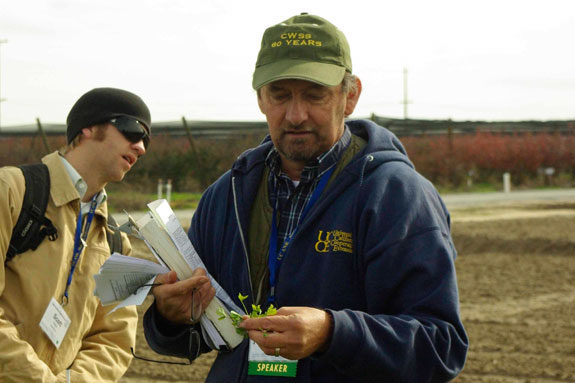More than 60 companies exhibited their products. The meetings were held Dec. 1-3, in Visalia, California.
This annual conference is organized by the University of California Alfalfa Workgroup and this year saw its return to the San Joaquin Valley after four years in other locations.
The San Joaquin Valley contains roughly 50 percent of the state’s acreage and is the center of the state’s large dairy industry.
The first day was an intensive workshop on integrated pest management for alfalfa. This part of the symposium was held at the University of California Kearney Research and Extension Center, which allowed for field demonstrations as well as lab demos and lectures.
Methods to protect water quality from field run-off were covered as well as a discussion on air quality and the impact of pesticide formulation as it relates to smog formation. Weed control, diseases, nematodes and insects were covered by experts in those fields.
The weather cooperated and attendees basked in the winter sun during the mid-day field trip to see herbicide and rodent trap demonstrations. Dr. Roger Baldwin from the UC Davis IPM group demonstrated different types of traps and the correct way to set them.
UC Cooperative Extension Farm Advisor, Kurt Hembree, talked about the advantages and disadvantages of various herbicides in seedling alfalfa, stressing the need to apply herbicides when weeds are small. More than 120 people attended this pre-Symposium workshop.
On the following day, the Symposium began with a series of talks on the economics, covering alfalfa hay price trends, the outlook for the dairy industry in the coming year, and the impact of global trade on forage, feeds and milk.
Several presentations on topics that covered both the advantages and the problems of alfalfa and forage production in relation to environmental issues were presented.
Alex Hartman from California Audubon explained how alfalfa is critical habitat for animals and birds, especially as the natural landscape has been converted to not only farming but to urban landscapes in California.
He explained in particular the importance of alfalfa to three bird species: the white-faced ibis, the long-billed curlew, and the Swainson’s hawk.
While acknowledging that there can be problems when farming and wildlife intersect, he sought to encourage growers to consider how they might work together with Audubon to help with habitat development while minimizing impacts on the farming enterprise.
Dr. Dan Putnam sought to cover the breadth of the issue by presenting a list of the positives and negatives of forage production from an environmental viewpoint.
Critics of alfalfa often cite its high water use and “low value.” But as a contributor to the very high value dairy industry, alfalfa’s value should be measured not just by the dollar value at the farm gate but within the scope of its broader economic contribution.
The afternoon session on alfalfa covered integrated pest management for pocket gophers, summer weed control, and nematodes. Dr. Mike Ottman form the University of Arizona discussed alfalfa’s nutritional needs and fertilization requirements. He also discussed nutrition deficiency symptoms.
This year the Symposium made a concerted effort to not only cover many aspects of alfalfa production but also to have a breakout session on corn silage and other forages.
Because of the large dairy industry in the San Joaquin Valley, the area leads the state in corn and cereals production, the vast majority of it ensiled.

UC Cooperative Extension Dairy Advisors Jennifer Heguy, Noelia Silva-del Rio, and Carol Collar provided a local view of silage management in California, including opportunities to improve silage quality and the challenges facing custom choppers.
Nationally known expert Dr. Limin Kung Jr. from the University of Delaware covered the biology and the aerobic stability of silage.
The latter is important not only to avoid the loss of dry matter and nutrients but also to minimize impacts on air quality. Silage exposed to air not only is degraded by microbes but also produces volatile organic compounds which can combine with engine exhaust to form smog.
Keith Bolsen, Professor Emeritus from Kansas State University, had everyone’s attention as he talked about the need for safety around silage equipment and the silage bunk. His case studies of actual incidents, often fatal, had everyone’s attention.
The last morning of talks looked to the future and addressed genetic developments in alfalfa and corn, through both conventional and biotech breeding methods. Improved digestibility and improved performance with less water were common themes for the two crops.
Dr. Anne Rodiek, from California State University – Fresno, talked about alfalfa from a horse’s point of view. While the needs of a working horse are quite different from an obese horse with insulin resistance, there can be a place for alfalfa in the ration for each type of horse. FG
—Information provided by University of California Cooperative Extension
Articles from the proceedings and some of the presentations are available at http://alfalfa.ucdavis.edu/+symposium/2010/. Scroll to the program for Dec. 1 and 2. Titles with proceedings articles will link to the article.
PHOTOS:
TOP: Kurt Hembree, UC Cooperative Extension Farm Advisor, shows the size of alfalfa when herbicides should be applied.
MIDDLE: IPM Workshop – Attendees listen to Kurt Hembree, Farm Advisor, UC Cooperative Extension, speak on timing herbicide applications to seedling alfalfa.
BOTTOM: Dr. Roger Baldwin, UC IPM Specialist, demonstrates how to set a rodent trap. Photos courtesy of Dr. Pete Goodell, UC IPM Specialist













